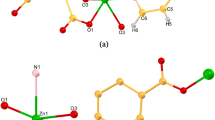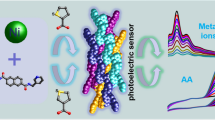Abstract
Macrocyclic compounds, such as crown ethers, azacrown ethers, thiacrown ethers, calixarenes and porphyrins, which act as ionophores in lead(II) ion-selective electrodes, are systematically summarized based on the latest literatures. The molecular structure characteristics of the ionophores are generalized. The modification regulations for the substituted ionophores are elaborated with the purpose of improving the response features of the lead(II) ion-selective electrodes assembled by them. It is pointed out that the introduction of pendant moieties which contain soft base coordination centers like N, S and P atoms is in favor of adjusting the cavity size and conformation of the macrocyclic compounds. Furthermore, there is synergic effect between the cavity and the donor sites of the ligand and thus the selective complexation of lead ions is easily realized, resulting in significant avoidance of the interference from other metal ions. The macrocyclic ionophore having the best response characteristics thus far was found to be N,N′-dimethylcyanodiaza-18-crown-6 with the detection limit of 7.0×10−8 (14.5 μg/L), which is one of the uncommon ionophores that can really eliminate the interference from silver and mercury ions. The selectivity coefficients of the ionophore for lead ions over other metal ions, such as alkali, alkaline earth and transition metal ions are in the order of 10−4 or smaller, where the selectivity coefficient of lead(II) over mercury(II) ions is much lower, down to 8.9×10−4. The structure design idea for high-performance ionophore is proposed according to present results. The incorporation of nitrogen atom, especially cyano group or thiocyano group or amino/imino groups, rather than thio atom alone could result in new excellent lead ionophores. The aborative design for metacyclophanes containing aromatic nitrogen atoms with the aim of creating excellent ionophores would also become a potential research trend. The lead(II) ion-selective electrodes have shown widely potential applications in the potentiometric titration, and flow injection potentiometry, and in the direct determination of lead in stack emissions of lead smelters, and assay of lead in rocks, particularly in the direct measurements of trace amount of lead(II) in human hair, blood, edible oil, food, water, and air.
Similar content being viewed by others
References
Rzewuska A, Wojciechowski M, Bulska E, et al. Composite polyacrylate-poly(3,4-ethylenedioxythiophene) membranes for improved all-solid-state ion-selective sensors. Anal Chem, 2008, 80(1): 321–327
Singh J D, Maheshwari M, Khan S, et al. Sterically encumbered hexakis(alkylseleno) benzenes: conformational behavior of hexakis(iso-propylselenomethyl)benzene toward Hg2+ ions on selective recognition. Tetrahedron Lett, 2008, 49: 117–121
Malon A, Vigassy T, Bakker E, et al. Potentiometry at trace levels in confined samples: ion-selective electrodes with subfemtomole detection limits.J Am Chem Soc, 2006, 128(25): 8154–8155
Ganjali M R, Norouzi P, Faridbod F, et al. One decade of research on ion-selective electrodes in iran (1996–2006). J Iran Chem Soc, 2007, 4(1): 1–29
Krakowiak K E, Bradshaw J S, Zamecka-Krakowiak D J. Synthesis of aza-crown ethers. Chem Rev, 1989, 89: 929–972
Srirastava S K, Gupta U K, Jain S. Determination of lead using a PVC-based crown-ether membrane. Analyst, 1995,120: 495–498
Sheen S R, Shih J S. Lead(II) ion-selective electrodes based on crown ethers. Analyst, 1992, 117: 1691–1695
Pouretedal H R, Keshavarz M H. Lead (II)-selective electrode based on dibenzodiaza-15-crown-4. Asian J Chem, 2004, 16(3–4): 1319–1326
Ganjali M R, Rouhollahi A, Mardan A R, et al. Lead ion-selective electrode based on 4’-vinylbenzo-15-crown-5 homopolymer. Microchem J, 1998, 60: 122–133
Su C C, Chang M C, Liu L K. New Ag+-and Pb2+-selective electrodes with lariat crown ethers as ionophores. Anal Chim Acta, 2001, 432: 261–267
Tavakkoli N, Shamsipur M. Lead selective electrode membrane based on dibenzopyridino-18-crown-6. Anal Lett, 1996, 29(13): 2269–2279
Mousavi M F, Sahari S, Alizadeh N, et al. Lead ion-selective membrane electrode based on 1,10-dibenzyl-1,10-diaza-18-crown-6. Anal Chim Acta, 2000, 414: 189–194
Yang X H, Kumar N, Chi H, et al. Lead-selective membrane electrodes based on dithiophene diazacrown ether derivatives. Electroanalysis, 1997, 9(7): 549–553
Gupta V K, Jain A K, Kumar P. PVC-based membranes of N,N′-dibenzyl-1,4,10,13-tetraoxa-7,16-diazacyclooctadecane as Pb(II)-selective sensor. Sens Actuators B, 2006, 120: 259–265
Luboch E, Wagner-Wysiecka E, Fainerman-Melnikova M, et al. Pyrrole azocrown ethers. Synthesis, complexation, selective lead transport and ion-selective membrane electrode studies. Supramol Chem, 2006, 18(7): 593–601
Yang X H, Kumar N, Hibbert D B, et al. Lead(II)-selective membrane electrodes based on 4,7,13,16-tetrathenoyl-1,10-dioxa-4,7,13,16-tetraazacyclooctadecane. Electroanalysis, 1998, 10(12): 827–831
Shamsipur M, Ganjali M R, Roihollahi A. Lead-selective membrane potentiometric sensor based on an 18-membered thiacrown derivative. Anal Sci, 2001, 17: 935–938
Ganjali M R, Hosseini M, Basiripour F, et al. Novel coated-graphite membrane sensor based on N,N′-dimethylcyanodiaza-18-crown-6 for the determination of ultra-trace amounts of lead. Anal Chim Acta, 2002, 464: 181–186
Zareh M M, Ghoneom A K, El-Aziz M H A. Effect of presence of 18-crown-6 on the response of 1-pyrrolidine dicarbodithioate-based lead selective electrode. Talanta, 2001, 54: 1049–1057
Amini M K, Mazloum M, Ensafi A A. Lead selective membrane electrode using cryptand(222) neutral carrier. Fresenius’ J Anal Chem, 1999, 364(8): 690–693
Gupta V K, Mangla R, Agarwal S. Pb(II) Selective Potentiometric Sensor Based on 4-tert-Butylcalix[4]arene in PVC Matrix. Electroanalysis, 2002, 14(15–16): 1127–1132
Bhat V S, Ijeri V S, Srivastava A K. Coated wire lead(II) selective potentiometric sensor based on 4-tert-butylcalix[6]arene. Sens Actuators B, 2004, 99: 98–105
Malinowska E, Brzozka Z, Kasiura K, et al. Lead selective electrodes based on thioamide functionalized calyx [4] arenes as ionophores. Anal Chim Acta, 1994, 298: 253–258
Lu J Q, Chen R, He X W. A lead ion-selective electrode based on a calixarene carboxyphenyl azo derivative. J Electroanal Chem, 2002, 528: 33–38
Chen L X, Zhang J, Zhao W F, et al. Double-armed calix[4]arene amide derivatives as ionophores for lead ion-selective electrodes. J Electroanal Chem, 2006, 589: 106–111
Bochenska M, Lesinska U. Lower rim substituted p-tert-butylcalix[4]arenes. Part 10. New Pb(II)-selective electrodes based on tetrasubstituted calix[4]arene with amides. Chem Anal (Warsaw), 2006, 51(6): 879–887
Cadogan F, Kane P, McKervey M A, et al. Lead-selective electrodes based on calixarene phosphine oxide derivatives. Anal Chem, 1999, 71(24): 5544–5550
Yaftian M R, Rayati S, Emadi D, et al. A coated wire-type lead(II) ion-selective electrode based on a phosphorylated calix[4]arene derivative. Anal Sci, 2006, 22: 1075–1078
Zhong Z M, Yao J X. Study on lead ion selective electrode based on calixarene phosphate as ionophore. Chin J Anal Chem (in Chinese), 2006, 34(4): 587
Jain A K, Gupta V K, Singh L P J, et al. A comparative study of Pb2+ selective sensors based on derivatized tetrapyrazole and calix[4]arene receptors. Electrochim Acta, 2006, 51: 2547–2553
Evtugyn G A, Stoikov I I, Beljyakova S V, et al. Ag selective electrode based on glassy carbon electrode covered with polyaniline and thiacalix[4]arene as neutral carrier. Talanta, 2007, 71: 1720–1727
Jose P, Menon S. Lower-rim substituted calixarenes and their applications. Bioinorganic Chemistry and Application, 2007, 2007, Article ID 65815, doi: 10.1155/2007/65815
Liu L, Han J, Yan C G. Progress in study of novel supramolecular host—thiacalixarene. Chin J Org Chem (in Chinese), 2007, 27(8): 907–917
Wang H, Li Z, Li Y. Synthesis and cationic selectivity studies of novel calix[4]arene derivatives containing heteroatom at the lower rim. Sci China B, Chem, 2007, 50(5): 654–659
Gupta V K, Jain A K, Maheshwari G, et al. Copper(II)-selective potentiometric sensors based on porphyrins in PVC matrix. Sens Actuators B, 2006, 117: 99–106
Gupta V K, Jain A K, Ishtaiwi Z, et al. Ni2+ selective sensors based on meso-tetrakis-{4-[tris-(4-allyl dimethylsilyl-phenyl)-silyl]-phenyl} porphyrin and (sal)2trien in poly(vinyl chloride) matrix. Talanta, 2007, 73: 803–811
Sadeghi S, Shamsipur M. Lead(II)-selective membrane electrode based on tetraphenylporphyrin. Anal Lett, 2000, 33(1): 17–28
Lee H K, Song K, Seo H R, et al. Lead(II)-selective electrodes based on tetrakis(2-hydroxy-1-naphthyl)porphyrins: the effect of atropisomers. Sens Actuators B, 2004, 99: 323–329.
Zhang W J, Li C Y, Zhang X B, et al. Synthesis of an amide-linked diporphyrin xanthene as a neutral carrier for a lead(II)-sensitive electrode. Anal Lett, 2007, 40(6): 1023–1035
Bouabdallah I, Zidane, Hacht B, et al. Liquid-liquid extraction of copper (II), cadmium (II) and lead (II) using tripodal N-donor pyrazole ligands. Arkivoc, 2006, (xi): 59–65
Radi S, Ramdani A, Lekchiri Y, et al. New tetrapyrazolic macrocycle. synthesis and preliminary use in metal ion extraction. Tetrahedron, 2004, 60: 939–942
Guo S J, Luo K, Wang W H, et al. Design and synthesis of novel chiral imidazolium cyclophanes and their enantioselective recognition for α-amino acids and their derivatives. Chem J Chin Univ (in Chinese), 2006, 27(9):1664–1668
Radu A, Peper S, Bakker E, et al. Guidelines for improving the lower detection limit of ion-selective electrodes: a systematic approach. Electroanalysis, 2007, 19(2–3): 144–154
Szigeti Z, Vigassy T, Bakker E, et al. Approaches to improving the lower detection limit of polymeric membrane ion-selective electrodes. Electroanalysis, 2006, 18(13–14): 1254–1265
Li X G, Huang M R, Duan W, et al. Novel multifunctional polymers from aromatic diamines by oxidative polymerizations. Chem Rev, 2002, 102: 2925–3030
Huang M R, Peng Q Y, Li X G. Rapid and effective adsorption of lead ions on fine polyphenylenediamine microparticles. Chem Eur J, 2006, 12: 4341–4350
Lü Q F, Huang M R, Li X G. Synthesis and heavy metal-ion sorption of pure sulfophenylenediamine copolymer nanoparticles with intrinsic conductivity and selfstability. Chem Eur J, 2007, 13: 6009–6018
Li X G, Li H, Huang M R. Productive synthesis and multifunctionality of polydiaminoanthraquinone and its pure nanoparticles with inherent selfstability and adjustable conductivity. Chem Eur J, 2007, 13: 8884–8896
Xu W T, Zhu R H. Preparation of β-cyclodextrin modified organic polymeric monolithic substrate and its application in room temperature phosphorescence. Chin J Anal Chem (in Chinese), 2008, 36(2): 201–205
Liu H L, Zhu G P. Calcium ion selective electrode modified with β-cyclodextrin crosslinking polymer inclusion complex. Chin J Anal Lab (in Chinese), 2004, 23(4): 52–54
Author information
Authors and Affiliations
Corresponding author
Additional information
Supported by the National Natural Science Foundation of China (Grant No.20774065)
About this article
Cite this article
Huang, M., Ma, X. & Li, X. Macrocyclic compound as ionophores in lead(II) ion-selective electrodes with excellent response characteristics. Chin. Sci. Bull. 53, 3255–3266 (2008). https://doi.org/10.1007/s11434-008-0449-4
Received:
Accepted:
Published:
Issue Date:
DOI: https://doi.org/10.1007/s11434-008-0449-4




